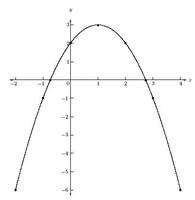
Intervals Quadratic
Quiz
•
Mathematics
•
9th Grade
•
Medium
+3
Standards-aligned

Anthony Clark
Used 1+ times
FREE Resource
14 questions
Show all answers
1.
MULTIPLE CHOICE QUESTION
1 min • 5 pts

Where is the function decreasing?
(-∞, -1)
(-1, ∞)
(-∞, 3)
(-∞, ∞)
Tags
CCSS.HSF-IF.C.7A
2.
MULTIPLE CHOICE QUESTION
1 min • 5 pts

Which answer choice best represents the domain and range of the function?
3.
MULTIPLE CHOICE QUESTION
1 min • 5 pts

What is the range of the graph?
All real numbers
Tags
AI.9.6.A
4.
MULTIPLE CHOICE QUESTION
1 min • 5 pts

Describe the end behavior of the graph.
x →∞, y→⁻∞ and x →⁻∞,y→⁻∞
x →∞, y→∞ and x→⁻∞, y→∞
x →∞, y→∞ and x→⁻∞, y→0
x →∞,y→∞ and x→⁻∞, y→⁻∞
Tags
CCSS.HSF-IF.C.7A
5.
MULTIPLE CHOICE QUESTION
1 min • 5 pts

What is the range of the graph?
[1, ∞)
(1, ∞)
(-∞, ∞)
none of these
Tags
CCSS.8.F.A.1
CCSS.HSF.IF.B.5
6.
FILL IN THE BLANK QUESTION
1 min • 1 pt

On what interval is the graph of k concave down?
(type with no spaces)
7.
MULTIPLE CHOICE QUESTION
1 min • 1 pt

The table shows values for a function k at selected values of x. Which of the following claim and explanation statements best fit these data?
k is the best modeled by a linear function because the rate of change over consecutive equal-length input-value intervals is constant
k is the best modeled by a linear function because the rate of change over consecutive equal-length input-value intervals is linear
k is the best modeled by a quadratic function because the rate of change over consecutive equal-length input-value intervals is constant
k is the best modeled by a quadratic function because the rate of change over consecutive equal-length input-value intervals is linear. The rate of change is changing at a constant rate of -1
Create a free account and access millions of resources
Similar Resources on Wayground

10 questions
Consecutive Integers Practice Review
Quiz
•
9th - 12th Grade

12 questions
Properties of Parallelograms
Quiz
•
9th - 12th Grade

10 questions
3.1 Identifying Angles Given Two Lines and a Transversal
Quiz
•
10th Grade

16 questions
Features of/Identifying Functions
Quiz
•
8th - 9th Grade

10 questions
Average rate of change
Quiz
•
8th - 9th Grade

15 questions
Arithmetics Sequences
Quiz
•
9th Grade - University

13 questions
Precalculus Transformations
Quiz
•
11th Grade - University

11 questions
Average Rate of Change
Quiz
•
9th - 12th Grade
Popular Resources on Wayground

10 questions
Lab Safety Procedures and Guidelines
Interactive video
•
6th - 10th Grade

10 questions
Nouns, nouns, nouns
Quiz
•
3rd Grade

10 questions
9/11 Experience and Reflections
Interactive video
•
10th - 12th Grade

25 questions
Multiplication Facts
Quiz
•
5th Grade

11 questions
All about me
Quiz
•
Professional Development

22 questions
Adding Integers
Quiz
•
6th Grade

15 questions
Subtracting Integers
Quiz
•
7th Grade

9 questions
Tips & Tricks
Lesson
•
6th - 8th Grade
Discover more resources for Mathematics

12 questions
Graphing Inequalities on a Number Line
Quiz
•
9th Grade

15 questions
Two Step Equations
Quiz
•
9th Grade

12 questions
Absolute Value Equations
Quiz
•
9th Grade

15 questions
Combine Like Terms and Distributive Property
Quiz
•
8th - 9th Grade

20 questions
Transformations of Functions
Quiz
•
9th Grade

20 questions
Multi-Step Equations and Variables on Both Sides
Quiz
•
9th - 12th Grade

10 questions
Literal Equations
Quiz
•
9th Grade

10 questions
Solving Absolute Value Equations
Quiz
•
8th - 9th Grade



